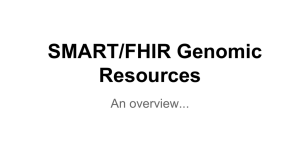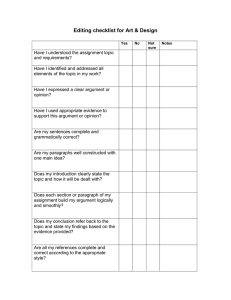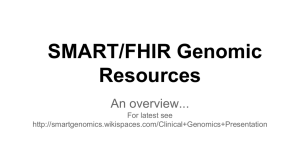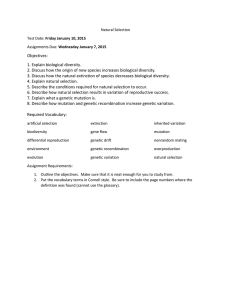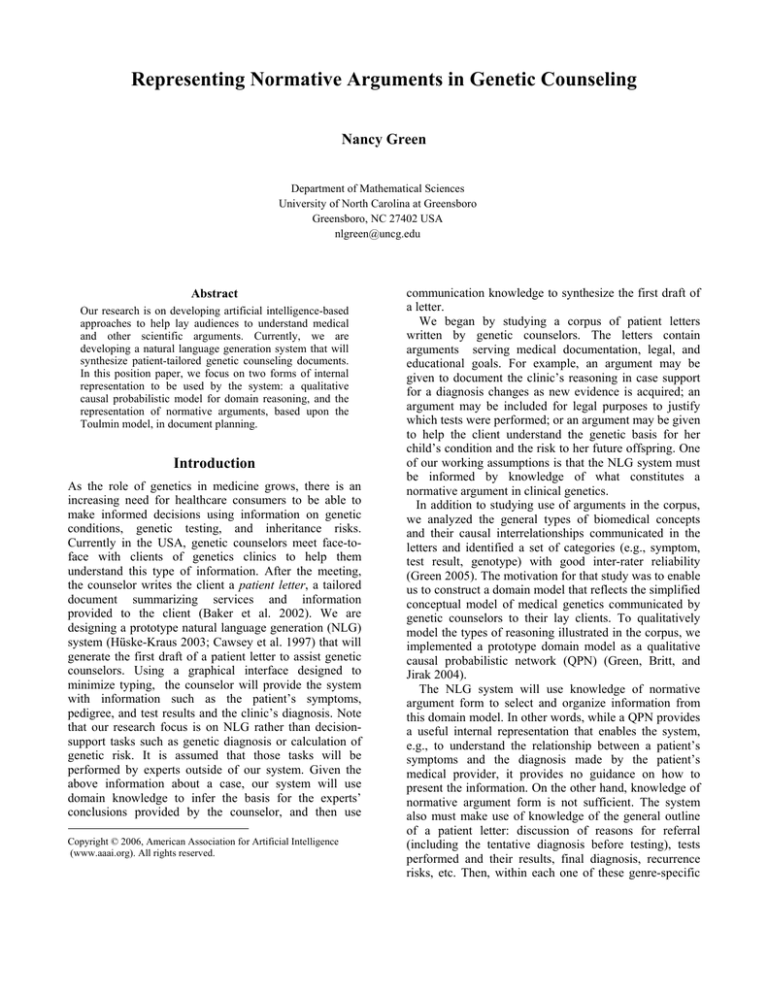
Representing Normative Arguments in Genetic Counseling
Nancy Green
Department of Mathematical Sciences
University of North Carolina at Greensboro
Greensboro, NC 27402 USA
nlgreen@uncg.edu
Abstract
Our research is on developing artificial intelligence-based
approaches to help lay audiences to understand medical
and other scientific arguments. Currently, we are
developing a natural language generation system that will
synthesize patient-tailored genetic counseling documents.
In this position paper, we focus on two forms of internal
representation to be used by the system: a qualitative
causal probabilistic model for domain reasoning, and the
representation of normative arguments, based upon the
Toulmin model, in document planning.
Introduction
As the role of genetics in medicine grows, there is an
increasing need for healthcare consumers to be able to
make informed decisions using information on genetic
conditions, genetic testing, and inheritance risks.
Currently in the USA, genetic counselors meet face-toface with clients of genetics clinics to help them
understand this type of information. After the meeting,
the counselor writes the client a patient letter, a tailored
document summarizing services and information
provided to the client (Baker et al. 2002). We are
designing a prototype natural language generation (NLG)
system (Hhske-Kraus 2003; Cawsey et al. 1997) that will
generate the first draft of a patient letter to assist genetic
counselors. Using a graphical interface designed to
minimize typing, the counselor will provide the system
with information such as the patient’s symptoms,
pedigree, and test results and the clinic’s diagnosis. Note
that our research focus is on NLG rather than decisionsupport tasks such as genetic diagnosis or calculation of
genetic risk. It is assumed that those tasks will be
performed by experts outside of our system. Given the
above information about a case, our system will use
domain knowledge to infer the basis for the experts’
conclusions provided by the counselor, and then use
Copyright © 2006, American Association for Artificial Intelligence
(www.aaai.org). All rights reserved.
communication knowledge to synthesize the first draft of
a letter.
We began by studying a corpus of patient letters
written by genetic counselors. The letters contain
arguments serving medical documentation, legal, and
educational goals. For example, an argument may be
given to document the clinic’s reasoning in case support
for a diagnosis changes as new evidence is acquired; an
argument may be included for legal purposes to justify
which tests were performed; or an argument may be given
to help the client understand the genetic basis for her
child’s condition and the risk to her future offspring. One
of our working assumptions is that the NLG system must
be informed by knowledge of what constitutes a
normative argument in clinical genetics.
In addition to studying use of arguments in the corpus,
we analyzed the general types of biomedical concepts
and their causal interrelationships communicated in the
letters and identified a set of categories (e.g., symptom,
test result, genotype) with good inter-rater reliability
(Green 2005). The motivation for that study was to enable
us to construct a domain model that reflects the simplified
conceptual model of medical genetics communicated by
genetic counselors to their lay clients. To qualitatively
model the types of reasoning illustrated in the corpus, we
implemented a prototype domain model as a qualitative
causal probabilistic network (QPN) (Green, Britt, and
Jirak 2004).
The NLG system will use knowledge of normative
argument form to select and organize information from
this domain model. In other words, while a QPN provides
a useful internal representation that enables the system,
e.g., to understand the relationship between a patient’s
symptoms and the diagnosis made by the patient’s
medical provider, it provides no guidance on how to
present the information. On the other hand, knowledge of
normative argument form is not sufficient. The system
also must make use of knowledge of the general outline
of a patient letter: discussion of reasons for referral
(including the tentative diagnosis before testing), tests
performed and their results, final diagnosis, recurrence
risks, etc. Then, within each one of these genre-specific
topics, the system can construct arguments for claims to
be presented on the current topic.
In addition to the above NLG tasks, the system must
make a variety of rhetorical and linguistic choices that
should have a significant effect on how well a lay
audience can understand the arguments, e.g., determining
presentation order of components of an argument and
which argument components to present explicitly, choice
of rhetorical cues (via word choice and syntactic form),
and choice of content words and phrasing. An important
issue in choice of content words and phrasing is the
expression of probabilities in a manner that is
comprehensible to a lay audience.
In this paper, our focus is on the relationship of the
causal probabilistic domain model to normative argument
structure. We shall analyze an excerpt from the corpus in
terms of these two models and discuss how they are
related.
Causal Probabilistic Representation
For general information on causal probabilistic networks
see, e.g., (Korb and Nicholson 2004). Figure 1 shows a
(simplified) subgraph of the system’s domain model
representing the biomedical content of the following
excerpt from a genetic counseling letter in the corpus. In
the excerpt, sentences have been numbered for discussion
purposes, and information in square brackets has been
used in place of confidential information.
(2) [DOCTOR] asked us to evaluate [PATIENT] to
determine if [HIS/HER] delays in development and
[BIRTH DEFECT] were due to a recognizable
genetic condition.
(3) During your appointment on [DATE], we obtained a
blood sample from [PATIENT].
(4) … a special analysis … was done to test for
Velocardiofacial syndrome (VCF).
(5) Individuals with VCF often have [BIRTH DEFECT]
and learning problems.
(6) A newly developed test … was also done.
(7) [PATIENT'S] … study … showed a normal result.
(8) It is important to remember that, even though these
tests were negative, [PATIENT'S] problems could
still be caused by a genetic alteration.
The network in Figure 1 contains four nodes, each
representing a discrete random variable. The domain of
each variable is given in parentheses. For more
information about the categories of variables that may be
used in the domain model see (Green 2005). The directed
arcs in this network represent direct causal dependencies
between nodes. The strength of the relationship between
variables is represented by means of qualitative influence
relations (Green, Britt, and Jirak 2004).
For the case represented in the above excerpt, a genetic
counselor using the system to draft a letter would select
the initial diagnosis of VCF. The system represents this
initial diagnosis in the network in Figure 1 by setting the
probability to possible, at time pretest, that the genotypetype node labeled VCF genotype has the value 1 mutated
allele. (VCF is a condition due to having one mutated
allele of a certain gene in all of an individual’s cells.) The
system’s graphical interface then provides a list of
possible symptoms of VCF and related disorders. After
the genetic counselor has indicated which symptoms have
been observed, a birth defect and learning problems, this
would be represented in the network by setting the
probability to certain that the value of the symptom-type
node labeled Birth defect and learning problems is yes.
The arc from VCF genotype to Birth defect and
learning problems represents the potential causal
relation between the occurrence of VCF (i.e., having one
mutated allele for VCF) and those symptoms. Thus,
qualitative domain reasoning from observations is
consistent with the clinic’s initial diagnosis.
Similarly, the genetic counselor could indicate what
tests have been performed and their results. For the case
discussed in the excerpt, the inputs to the system would
be represented in the network by setting the probability
to certain, at time posttest, that the value of the resulttype node labeled VCF test results is negative. The arc
from VCF genotype to VCF test results represents
another potential causal relation, assuming that the
intervention of performing a test on the patient has been
performed. Thus, domain reasoning from the new
evidence is consistent with the experts’ final conclusion
that it is unlikely that the patient has VCF, represented in
the network by a lowered probability, at time posttest,
that VCF genotype has a value of 1 mutated allele.
In the network shown in Figure 1, another possible
cause of the observed systems is represented by the
genotype-type node labeled other genotype. (The domain
of this variable is specified as 0, 1, or 2 mutated alleles
since the unspecified condition could follow an autosomal
recessive inheritance pattern unlike VCF, which is
autosomal dominant.) The experts’ final conclusion that it
is possible that the patient has some other genetic
condition would be represented by setting the probability
to possible, at time posttest, that other genotype has the
value 2 mutated alleles. Given the qualitative influence
relations in this network from both VCF genotype and
other genotype to Birth defect and learning problems,
this conclusion is consistent with the increase in
probability, from time pretest to posttest, that other
genotype has the value 2 mutated alleles.
Argument Representation
Toulmin’s model of argument form (Toulmin 1998) is
applicable to many of the arguments found in the corpus.
Toulmin’s model was developed to describe norms of
argumentation in academic disciplines (van Eemeren and
Grootendorst et al. 1996). Recently, it has been used as a
framework for teaching evidence-based medicine
(Jenicek and Hitchcock 2005). In Toulmin’s model (as
summarized in van Eemeren and Grootendorst et al.
1996), the data are the facts used to defend a claim. The
warrant is the (sometimes implicit) principle that licenses
the claim, given the data. In addition, a qualifier may be
used to indicate the strength of the claim or the existence
of exceptions to the warrant, and a backing may be used
to justify the warrant; e.g., one form of backing is to give
the facts on which the warrant is based.
Now we shall analyze arguments conveyed in
sentences (2) through (8) of the excerpt in terms of
Toulmin’s model, and then give some correspondences
between the Toulmin argument representation and the
part of a domain model shown in Figure 1. (Although we
have not distinguished the qualifier component of the
arguments, each claim incorporates a qualitative indicator
of uncertainty.) Argument I is reconstructed below from
sentences (4), (2), and (5); it outlines the support, before
the test results were known, for the claim that the patient
has the VCF mutation and that it is responsible for his/her
symptoms.
Argument I
• Claim (in 4): [PATIENT] may have the VCF
mutation, which is responsible for his/her [BIRTH
DEFECT] and learning problems
• Data (in 2): [PATIENT] has [BIRTH DEFECT] and
learning problems
• Warrant (implicit): Presence of the VCF mutation
can cause [BIRTH DEFECT] and learning problems
• Backing (in 5): The conditional probability of
[BIRTH DEFECT] and learning problems, given the
presence of the VCF mutation, is high
Next, we analyze (7) and (8) as the realization of a chain
of three arguments supporting the final diagnosis, i.e.,
supporting the claim of Argument IV.
Argument II
• Claim (implicit): Unlikely that [PATIENT] has the
VCF mutation
• Data (in 7): [PATIENT’S] VCF test results were
negative
• Warrant (implicit): When testing has been performed,
presence of the VCF mutation should cause the VCF
test results to be positive
Argument III
• Claim (implicit): Unlikely that the VCF mutation is
responsible for [PATIENT’S] [BIRTH DEFECT]
and learning problems
•
•
Data (claim of Argument II): Unlikely that
[PATIENT] has the VCF mutation
Warrant (implicit): A precondition of responsible is
not satisified.
Argument IV
• Claim (in 8): [PATIENT] may have some other
(unspecified) genetic condition, which is responsible
for his/her [BIRTH DEFECT] and learning
problems
• Data (claim of Argument III): Unlikely that a VCF
mutation is responsible for [PATIENT’S] [BIRTH
DEFECT] and learning problems
• Warrant (implicit): Either the VCF mutation or some
other genetic mutation could be responsible for
[BIRTH DEFECT] and learning problems
Toulmin’s original model is not applicable to all of the
arguments found in the corpus. For example, consider
sentence (9), which follows (8) in the letter shown above.
(9) There are currently no specific tests for many of the
genetic changes that can cause birth defects and
learning problems.
We analyze this as a kind of dialectical argument, i.e., an
argument intended to address anticipated objections of the
audience to the writer’s claims, where the audience’s
objections are based upon incorrect information. In this
example, the writer may be addressing the mistaken belief
of the patient’s parents that the genetic testing performed
on the patient has ruled out the possibility of any genetic
basis for their child’s symptoms. We reconstruct this
argument, which supports the same claim as the claim of
Argument IV, as follows.
Argument V
• Claim (in 8): [PATIENT] may have some other
(unspecified) genetic condition, which is responsible
for his/her [BIRTH DEFECT] and learning
problems
• Audience’s Counter-argument (implicit):
• Claim: [PATIENT] has no genetic condition
• Data: [PATIENT’S] VCF test results were
negative
• Warrant: When testing has been performed,
presence of any genetic condition should cause the
VCF test results to be positive
• Conceded Data (in 8): [PATIENT’S] VCF test results
were negative
• Counter-Warrant (implicated in 9): The VCF test
does not identify other genetic conditions that can
cause birth defects and learning problems.
We plan to use normative argument structures such as
the above as intermediate representations during the
generation process. Given a claim, the system will extract
information from its domain model to supply data (or
conceded data), warrant (or counter-warrant), and
backing (if any). A combination of corpus-based and
empirical methods will be used to transform this internal
representation into text. We assume that the
transformation of domain information to text will be more
straightforward if the system has access to the role of the
information to be presented in the underlying arguments
than if no such information were available.
Next we shall illustrate what information would be
extracted from the domain model to fill the different
components in some of the above arguments. For
example, the part of the claim of Argument I that the
patient may have the VCF mutation maps to the following
in the network in Figure 1: at time pretest, the qualitative
probability is possible that the variable VCF genotype
has the value 1 mutated allele. The other part of the
claim, that this mutation is responsible for the patient’s
symptoms, maps to the probability of VCF genotype
having the value 1 mutated allele being higher than some
threshold and higher than the probability of any other
possible causes at time pretest. The data of Argument I
maps to the belief that it is certain that Birth defect and
learning problems is yes. The warrant maps to the
relation of positive causal influence represented by the arc
from VCF genotype to Birth defect and learning
problems. The backing for the warrant of Argument I is a
qualitative conditional probability statement that maps to
information outside of the network justifying that causal
influence relation. The mappings from Arguments II
through IV to the domain model are similar to the above.
The audience’s counter-argument in Argument V could
be mapped to a network representing a model of the
audience’s supposed beliefs like the one shown in Figure
1, but with an arc representing positive causal influence
from other genotype to VCF test results.
Conclusion
This paper described two forms of internal representation
to be used by a natural language generation system during
synthesis of the first draft of lay-oriented genetic
counseling
documents.
The
qualitative
causal
probabilistic model reflects the simplified conceptual
model of this domain used by genetic counselors in
communication with their clients. However, the domain
model does not represent what constitutes a normative
argument in this genre. Thus, the presentation of
information from this model will be informed by a
representation of normative arguments based upon the
Toulmin model. The next step in our research is to focus
on the transformation of the normative argument
representation into a presentation that is comprehensible
to a lay audience. A combination of corpus-based and
empirical methods will be used.
Acknowledgments
This material is based upon work supported by the
National Science Foundation under CAREER Award No.
0132821.
References
Baker, D.L., Eash, T., Schuette, J.L., Uhlmann, W.R. 2002.
Guidelines for writing letters to patients. J Genetic Counseling
11(5):399-418.
Cawsey, A.J., Webber, B.L., Jones, R.B. 1997. Natural language
generation in health care. J. Am Med Inform Assoc 4(6):473-82.
van Eemeren, F.H., Grootendorst, R., et al. 1996. Fundamentals
of argumentation theory: a handbook of historical backgrounds
and contemporary developments.: Lawrence Erlbaum
Associates, Mahway, New Jersey.
Green, N. 2005. A Bayesian network coding scheme for
annotating biomedical information presented to genetic
counseling clients. J. Biomedical Informatics 38:130-44.
Green, N., Britt, T., and Jirak, K. 2004. Communication of
Uncertainty in Genetic Counseling Patient Education Systems.
In AAAI 2004 Fall Symposium on Dialogue Systems for Health
Communication.
Hhske-Kraus, D. 2003. Text generation in clinical medicine – A
review. Methods Inf Med 42:51-60.
Jenicek, M. and Hitchcock, D. L. 2005. Logic and Critical
Thinking in Medicine. AMA Press.
Korb, K., Nicholson, A.E. 2004. Bayesian artificial intelligence.
Chapman Hall/CRC, Boca Raton, Florida.
Toulmin, S.E. 1998. The uses of argument. (9th ed.) Cambridge
University Press, Cambridge, England.
VCF genotype
(0 or 1 mutated alleles)
VCF test results
(negative or positive)
Figure 1. Causal network for excerpt.
other genotype
(0 , 1 or 2 mutated alleles)
Birth defect and learning
problems (yes or no)

